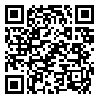Volume 81, Issue 4 (July 2023)
Tehran Univ Med J 2023, 81(4): 273-280 |
Back to browse issues page
Download citation:
BibTeX | RIS | EndNote | Medlars | ProCite | Reference Manager | RefWorks
Send citation to:



BibTeX | RIS | EndNote | Medlars | ProCite | Reference Manager | RefWorks
Send citation to:
Zamani S, Sasani M R, Saeedi-Moghadam M. Assessment of STIR and contrast-enhanced MRI sequences
in detection of diabetic foot osteomyelitis. Tehran Univ Med J 2023; 81 (4) :273-280
URL: http://tumj.tums.ac.ir/article-1-12504-en.html
URL: http://tumj.tums.ac.ir/article-1-12504-en.html
1- Department of Radiology, School of Medicine, Shiraz University of Medical Sciences, Shiraz, Iran.
2- Department of Radiology, School of Medicine, Medical Imaging Research Center, Shiraz University of Medical Sciences, Shiraz, Iran.
3- Medical Imaging Research Center, Shiraz University of Medical Sciences, Shiraz, Iran.
2- Department of Radiology, School of Medicine, Medical Imaging Research Center, Shiraz University of Medical Sciences, Shiraz, Iran.
3- Medical Imaging Research Center, Shiraz University of Medical Sciences, Shiraz, Iran.
Abstract: (935 Views)
Background: MRI is the imaging modality of choice for the detection of diabetic pedal osteomyelitis. The aim of this study is to compare the STIR sequence, as the most important fluid-sensitive sequence, with contrast-enhanced images for diagnosing diabetic pedal osteomyelitis.
Methods: Medical images were compared. Moreover, the effect of adding T1W image findings to the STIR sequence was evaluated. This cross sectional study was collected and analyzed at Namazi Hospital, Shiraz University of Medical Sciences, from 20 March 2016 to 22 September 2017.
Results: The final diagnosis of osteomyelitis was confirmed for 47 bones (78%). 13 bones (22%) didn't have osteomyelitis. The specificity of contrast-enhanced and STIR sequences was 92.3% and 53.8%, respectively; whereas the sensitivity of the two sequences was similar (100%). Records of 48 diabetic patients suspected of having pedal osteomyelitis referred to one of the university hospitals, who underwent foot MRI with and without contrast injection, were assessed. Overall, 48 Patient MRIs and 60 separate bony parts were evaluated. Diagnoses were confirmed by clinical correlation. Finally, sensitivity, specificity and diagnostic accuracy of STIR sequence and contrast-enhanced images were compared. Moreover, the effect of addition of T1W image findings to STIR sequence was evaluated.
Conclusion: This study was performed to suggest a pulse sequence that doesn’t need contrast media injection for diagnosing diabetic pedal osteomyelitis since the previous studies showed that gadolinium-based contrast media shouldn’t be applied in patients with renal failure (glomerular filtration rate<30 ml/min/1.73m2. According to the results STIR images had the same sensitivity as T1 post-contrast images; therefore, it can be concluded that contrast media injection can be avoided using this pulse sequence. The specificity of the STIR pulse sequence was lower than that of post-contrast images which was due to the lower ability of this pulse sequence to detect secondary symptoms of osteomyelitis such as cortex disruption, sinus path, and abscess. Using the T1 pre-contrast images, specificity and diagnostic accuracy increased. Finally, it can be concluded that MRI without contrast including STIR and pre-contrast T1W images is a reliable modality for the detection of osteomyelitis in suspected diabetic patients who are more prone to renal disorders.
Methods: Medical images were compared. Moreover, the effect of adding T1W image findings to the STIR sequence was evaluated. This cross sectional study was collected and analyzed at Namazi Hospital, Shiraz University of Medical Sciences, from 20 March 2016 to 22 September 2017.
Results: The final diagnosis of osteomyelitis was confirmed for 47 bones (78%). 13 bones (22%) didn't have osteomyelitis. The specificity of contrast-enhanced and STIR sequences was 92.3% and 53.8%, respectively; whereas the sensitivity of the two sequences was similar (100%). Records of 48 diabetic patients suspected of having pedal osteomyelitis referred to one of the university hospitals, who underwent foot MRI with and without contrast injection, were assessed. Overall, 48 Patient MRIs and 60 separate bony parts were evaluated. Diagnoses were confirmed by clinical correlation. Finally, sensitivity, specificity and diagnostic accuracy of STIR sequence and contrast-enhanced images were compared. Moreover, the effect of addition of T1W image findings to STIR sequence was evaluated.
Conclusion: This study was performed to suggest a pulse sequence that doesn’t need contrast media injection for diagnosing diabetic pedal osteomyelitis since the previous studies showed that gadolinium-based contrast media shouldn’t be applied in patients with renal failure (glomerular filtration rate<30 ml/min/1.73m2. According to the results STIR images had the same sensitivity as T1 post-contrast images; therefore, it can be concluded that contrast media injection can be avoided using this pulse sequence. The specificity of the STIR pulse sequence was lower than that of post-contrast images which was due to the lower ability of this pulse sequence to detect secondary symptoms of osteomyelitis such as cortex disruption, sinus path, and abscess. Using the T1 pre-contrast images, specificity and diagnostic accuracy increased. Finally, it can be concluded that MRI without contrast including STIR and pre-contrast T1W images is a reliable modality for the detection of osteomyelitis in suspected diabetic patients who are more prone to renal disorders.
|
|
Type of Study: Original Article |
| Rights and permissions | |
 |
This work is licensed under a Creative Commons Attribution-NonCommercial 4.0 International License. |





